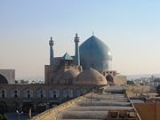
Shah Mosque
Overview
Mosque
A mosque is a place of worship for followers of Islam. The word is likely to have entered the English language through French , from Portuguese , from Spanish , and from Berber , ultimately originating in — . The Arabic word masjid literally means a place of prostration...
in Isfahan
Isfahan (city)
Isfahan , historically also rendered in English as Ispahan, Sepahan or Hispahan, is the capital of Isfahan Province in Iran, located about 340 km south of Tehran. It has a population of 1,583,609, Iran's third largest city after Tehran and Mashhad...
, Iran
Iran
Iran , officially the Islamic Republic of Iran , is a country in Southern and Western Asia. The name "Iran" has been in use natively since the Sassanian era and came into use internationally in 1935, before which the country was known to the Western world as Persia...
standing in south side of Naghsh-i Jahan Square
Naghsh-i Jahan Square
Naqsh-e Jahan Square , known as Imam Square , formerly known as Shah Square , is a square situated at the center of Isfahan city, Iran. Constructed between 1598 and 1629, it is now an important historical site, and one of UNESCO's World Heritage Sites...
.
Built during the Safavid period, it is an excellent example of Islamic architecture
Islamic architecture
Islamic architecture encompasses a wide range of both secular and religious styles from the foundation of Islam to the present day, influencing the design and construction of buildings and structures in Islamic culture....
of Iran, and regarded as one of the masterpieces of Persian Architecture
Iranian architecture
Iranian architecture or Persian architecture is the architecture of Iran . It has a continuous history from at least 5000 BCE to the present, with characteristic examples distributed over a vast area from Turkey to North India and the borders of China and from the Caucasus to Zanzibar...
. The Shah Mosque of Esfahan is one of the everlasting masterpieces of architecture in Iran. It is registered, along with the Naghsh-i Jahan Square, as a UNESCO
UNESCO
The United Nations Educational, Scientific and Cultural Organization is a specialized agency of the United Nations...
World Heritage Site
World Heritage Site
A UNESCO World Heritage Site is a place that is listed by the UNESCO as of special cultural or physical significance...
. Its construction began in 1611, and its splendor is mainly due to the beauty of its seven-colour mosaic tiles and calligraphic
Calligraphy
Calligraphy is a type of visual art. It is often called the art of fancy lettering . A contemporary definition of calligraphic practice is "the art of giving form to signs in an expressive, harmonious and skillful manner"...
inscriptions.
The mosque
Mosque
A mosque is a place of worship for followers of Islam. The word is likely to have entered the English language through French , from Portuguese , from Spanish , and from Berber , ultimately originating in — . The Arabic word masjid literally means a place of prostration...
is one of the treasures featured on Around the World in 80 Treasures
Around the World in 80 Treasures
Around the World in 80 Treasures is a 10 episode art and travel documentary series by the BBC, presented by Dan Cruickshank, and originally aired in February, March, and April 2005...
presented by the architecture historian Dan Cruickshank
Dan Cruickshank
Dan Cruickshank is an art historian and BBC television presenter.-Early life:As a young child he lived for some years in Poland...
.
The mosque is depicted on the reverse
Obverse and reverse
Obverse and its opposite, reverse, refer to the two flat faces of coins and some other two-sided objects, including paper money, flags , seals, medals, drawings, old master prints and other works of art, and printed fabrics. In this usage, obverse means the front face of the object and reverse...
of the Iranian 20,000 rials
Iranian rial
The rial is the currency of Iran. It is subdivided into 100 dinar but, because of the very low current value of the rial, no fraction of the rial is used in accounting....
banknote.
In 1598, when Shah Abbas
Abbas I of Persia
Shāh ‘Abbās the Great was Shah of Iran, and generally considered the greatest ruler of the Safavid dynasty. He was the third son of Shah Mohammad....
decided to move the capital of his Persian empire from the northwestern city of Qazvin
Qazvin
Qazvin is the largest city and capital of the Province of Qazvin in Iran. At the 2006 census, its population was 349,821, in 96,420 families....
to the central city of Isfahan, he initiated what would become one of the greatest programmes in Persian history; the complete remaking of this ancient city.

